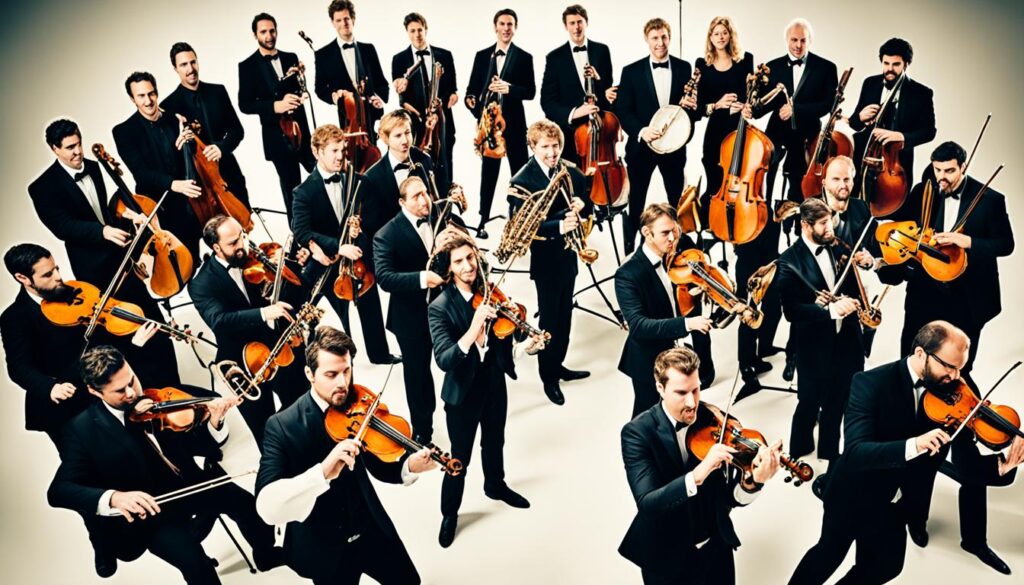Team dynamics in the workplace play a critical role in the success of organizations. They can either fuel collaboration, communication, and productivity, or hinder them. Let me illustrate this with a relatable story. One day, a marketing team was tasked with launching a new campaign. Initially, the differing personalities and work styles created friction, with some members dominating conversations while others hesitated to share their ideas. However, as they began to understand and respect each other’s strengths, the team dynamics in the workplace transformed, leading to a surge of creativity and cooperation that ultimately resulted in a successful campaign launch.
Meet Sarah and Jack, two talented individuals working for a leading tech company. Sarah is a brilliant coder with a knack for problem-solving, while Jack is a skilled designer who brings creativity to every project. Individually, they excel in their respective roles, but when they are assigned to collaborate on a project, things start to unravel.
Their communication is limited, with Sarah preferring concise messages and Jack favoring lengthy discussions. Misunderstandings arise, and tasks get duplicated or overlooked, leading to frustration and delays. The team’s morale suffers, and the quality of their work diminishes.
This situation may sound familiar to you. It highlights the importance of team dynamics in the workplace. In order to harness the full potential of their talents, Sarah and Jack need to understand and improve their collaboration and communication strategies.
Key Takeaways:
- Team dynamics in the workplace impact collaboration, communication, and productivity.
- Effective collaboration and communication strategies are key to enhancing team dynamics.
- Understanding individual differences and finding common ground is essential for successful teamwork.
- Investing in team building activities can strengthen relationships and improve team dynamics.
- Continuous improvement and open communication are crucial for fostering positive team dynamics.
What is Team Dynamics at Work?
Team dynamics at work encompass the interactions, relationships, and behaviors among individuals within a team. It includes formal aspects such as roles and responsibilities, as well as informal aspects like interpersonal relationships and communication styles. Key elements of team dynamics include communication patterns, power structures, conflict resolution strategies, and the level of trust within the team. Team dynamics are not limited to formal meetings or projects but extend to informal interactions and digital communication channels.
| Elements of Team Dynamics | Description |
|---|---|
| Roles and Responsibilities | Defines the tasks and responsibilities assigned to each team member |
| Communication Patterns | Refers to the flow and frequency of communication within the team |
| Power Structures | Examines the distribution of authority and decision-making within the team |
| Conflict Resolution Strategies | Addresses the methods used to manage and resolve conflicts within the team |
| Trust | Reflects the level of confidence and reliability among team members |
The Importance of Team Dynamics in the Workplace
Team dynamics play a pivotal role in shaping the success and productivity of a workplace. Positive team dynamics enhance collaboration, improve communication, and foster higher morale and motivation among team members. When team members feel connected and valued, they are more likely to work together effectively, share ideas, and contribute their best efforts towards achieving common goals.
Enhanced collaboration is a key outcome of positive team dynamics. When team members collaborate effectively, they leverage their diverse skills, knowledge, and perspectives to generate innovative solutions and make more informed decisions. This collaborative approach not only improves productivity but also fosters a sense of ownership and shared responsibility among team members.
Improved communication is another significant benefit of positive team dynamics. When team members feel comfortable sharing their thoughts and ideas, it leads to clear and effective communication throughout the team. This reduces misunderstandings, enhances efficiency, and minimizes conflicts that may arise due to miscommunication or lack of information.
“Positive team dynamics create an environment where team members can freely express themselves and actively listen to others. This promotes open and honest communication, fostering stronger relationships and a deeper understanding of each other’s perspectives.”
Higher morale and motivation are also consequences of positive team dynamics. When team members feel supported, respected, and part of a cohesive team, their morale is boosted, and they are more motivated to exceed expectations. Positive team dynamics create a sense of purpose, belonging, and camaraderie, which in turn leads to higher job satisfaction and increased motivation to achieve individual and collective goals.
In summary, cultivating positive team dynamics is essential for any organization aiming to create a cohesive and high-performing workforce. Enhanced collaboration, improved communication, higher morale, and motivation are key advantages of positive team dynamics. By investing in teamwork, organizations can foster a positive work environment that empowers employees, promotes creativity and innovation, and ultimately drives sustainable growth.

Examples of Team Dynamics
Understanding how team members interact with each other is crucial in building effective team dynamics. Here are some examples that demonstrate the impact of different interaction styles on overall team performance and cohesion:
-
Collaborative Orchestra: In this dynamic, team members with diverse skills and expertise collaborate harmoniously, much like musicians in an orchestra. They work together to solve problems, leveraging each other’s strengths and abilities to achieve a common goal. This collaborative approach fosters a sense of synergy and creates an efficient and innovative team environment.

- Constructive Challenger: A constructive challenger is someone who questions assumptions, encourages critical thinking, and challenges the status quo within the team. By stimulating intellectual debates and promoting alternative perspectives, the constructive challenger pushes the team to explore different possibilities and make well-informed decisions. This dynamic fosters creativity, prevents groupthink, and drives continuous improvement.
- Synergy Spark: The synergy spark dynamic occurs when team members inspire and motivate each other. These individuals bring positivity, energy, and enthusiasm to the team, creating a ripple effect that boosts morale and collaboration. The synergy spark ignites creativity, encourages cooperation, and drives team members to go above and beyond their ordinary efforts, resulting in exceptional outcomes.
- Mentorship Nexus: In this dynamic, a more experienced team member takes on the role of a mentor, guiding and supporting junior colleagues. The mentorship nexus promotes knowledge sharing, skill development, and personal growth among team members. The mentor acts as a source of guidance, motivation, and inspiration, fostering a culture of learning and continuous improvement within the team.
- Inclusion Initiator: The inclusion initiator ensures that every team member’s voice is heard and valued, particularly in diverse teams. They create an inclusive environment where individuals from different backgrounds and perspectives feel comfortable contributing their ideas and opinions. This dynamic promotes teamwork, empathy, and understanding, ultimately leading to better decision-making and innovative solutions.
These examples illustrate the diverse nature of team dynamics and how they can shape the performance and cohesiveness of a team. By leveraging the strengths of each dynamic and fostering a culture that embraces collaboration, critical thinking, motivation, mentoring, and inclusion, organizations can unlock their teams’ full potential and achieve greater success.
The Three Categories in Team Dynamics
Team dynamics play a crucial role in the success of any organization. Understanding the different categories of team dynamics can provide valuable insights into how teams collaborate, communicate, and achieve their goals. There are three main categories of team dynamics: task-related dynamics, social dynamics, and individual dynamics.
Task-Related Dynamics
Task-related dynamics focus on how team members work together to accomplish their goals. This category includes various aspects such as defining roles and responsibilities, effective communication, decision-making processes, and conflict management strategies. By establishing clear expectations and roles within the team, members can collaborate more efficiently and achieve better results. Effective communication ensures that information flows smoothly, ideas are shared, and everyone is aligned towards a common objective. Decision-making and conflict resolution strategies help overcome obstacles and maintain productivity within the team.
Social Dynamics
Social dynamics encompasses the relationships and interactions among team members. It includes factors such as trust, team identity, interpersonal relationships, and diversity and inclusion. Building trust among team members is essential for effective collaboration and a positive working environment. Team identity and a sense of belonging promote stronger cohesion and a shared commitment towards team goals. Interpersonal relationships build rapport, encourage teamwork, and enhance communication. Embracing diversity and inclusion fosters a culture of respect, creativity, and innovation within the team.
Individual Dynamics
Individual dynamics focus on each team member’s contributions, growth, and development. It takes into account factors such as motivation, skills and expertise, personal development, recognition, and feedback. Motivation plays a vital role in driving individual performance and overall team success. Nurturing individual skills and expertise enhances the team’s overall capabilities. Supporting personal development and growth not only benefits the individual but also contributes to the team’s long-term success. Recognizing and providing feedback on individual achievements helps build morale and foster a positive team environment.
Understanding and managing these three categories of team dynamics are essential for building successful teams. Organizations that effectively balance task-related dynamics, social dynamics, and individual dynamics can maximize team performance, collaboration, and overall success.
Common Challenges in Achieving Positive Team Dynamics
Creating and maintaining positive team dynamics can be a complex task, as there are various challenges that can hinder progress and productivity within a team.
Communication barriers are one of the common challenges that teams face. Ineffective communication and a lack of transparency can lead to misunderstandings, confusion, and a breakdown in collaboration. When team members are unable to effectively convey their thoughts, ideas, or concerns, it becomes difficult to establish trust and build strong working relationships.
Conflicts and disagreements are another challenge in achieving positive team dynamics. Differences in opinions, work styles, and approaches can lead to tension and discord within a team. Conflicts can arise when team members have conflicting goals or when there is a lack of clarity in roles and responsibilities. Resolving conflicts and managing disagreements in a constructive manner is essential to maintain a positive team dynamic.
A lack of trust among team members can significantly impact team dynamics. Trust is the foundation of effective teamwork, and without it, collaboration and open communication become difficult. When team members don’t trust each other, it can lead to self-preservation behaviors, lack of support, and reluctance to share information or take risks.
Other challenges that teams may face include underperformance and a lack of accountability. When team members do not take personal responsibility for their actions and outcomes, it can negatively impact the overall team dynamic. Addressing these challenges requires a proactive approach and a commitment to fostering positive team dynamics.
Implementing strategies such as effective communication, conflict resolution training, and clear goal setting can help overcome these challenges. By promoting open and transparent communication, teams can break down barriers and foster mutual understanding. Conflict resolution training equips team members with the skills and techniques to resolve conflicts constructively, allowing for healthy discussions and problem-solving. Additionally, establishing clear goals and expectations provides a framework for accountability and helps align team members towards a common purpose.
To summarize, achieving positive team dynamics requires addressing common challenges such as communication barriers, conflicts and disagreements, and a lack of trust. By tackling these challenges head-on and implementing strategies to foster open communication, conflict resolution, and clear goal setting, teams can create an environment conducive to collaboration, productivity, and overall success.
Strategies to Foster Positive Team Dynamics
Creating a positive team dynamic is crucial for achieving success in the workplace. By implementing the following strategies, organizations can build a collaborative and inclusive environment that enhances productivity and teamwork.
Establish Clear Goals and Expectations
Setting clear goals and expectations provide a shared vision for the team and helps align individual efforts towards a common objective. Clear goals provide direction and reduce ambiguity, fostering a sense of purpose among team members. When everyone understands what is expected of them, it minimizes confusion and reduces tension within the team.
Encourage Open Communication and Trust
Open communication is the foundation of effective teamwork. Encouraging team members to openly share ideas, concerns, and feedback creates a supportive environment where collaboration can thrive. Establishing trust within the team builds confidence and encourages individuals to freely express themselves without fear of judgment or reprisal.
Promote Diversity and Inclusion
A diverse and inclusive team brings together different perspectives, experiences, and ideas, leading to innovative solutions and better decision-making. By actively promoting diversity and inclusion, organizations create a culture of mutual respect and understanding. Valuing and harnessing the unique strengths of each team member contributes to a stronger and more cohesive team dynamic.
Provide Opportunities for Team Building Activities
Team building activities are an effective way to foster collaboration, improve communication, and strengthen team bonds. Engaging in activities such as team retreats, workshops, or recreational outings allows team members to connect on a personal level and develop a sense of camaraderie. These activities promote trust, facilitate problem-solving, and enhance overall teamwork.
Implementing these strategies contributes to the development of positive team dynamics, creating a work environment where individuals can thrive and collaborate effectively. By fostering clear goals and expectations, promoting open communication and trust, embracing diversity and inclusion, and providing opportunities for team building activities, organizations can cultivate a culture of teamwork that drives success.
Conclusion
Understanding and improving team dynamics is essential for organizations aiming to enhance collaboration, communication, and productivity. Positive team dynamics lead to effective conflict resolution, increased accountability, and a high-performance culture. By implementing strategies such as clear goal setting, open communication and trust-building, diversity and inclusion, and team building activities, organizations can foster positive team relationships and create a harmonious work environment. This, in turn, drives innovation, improves customer satisfaction, and maximizes overall success.
FAQ
What is team dynamics in the workplace?
Team dynamics in the workplace refer to the patterns of communication, cooperation, and collaboration within a team. It encompasses both formal aspects such as roles and responsibilities and informal aspects like interpersonal relationships and communication styles. Effective team dynamics in the workplace can significantly enhance productivity and job satisfaction among employees. When team members understand their roles and can communicate openly, it fosters an environment of trust and support, leading to innovative solutions and efficient problem-solving. Conversely, poor team dynamics in the workplace can result in misunderstandings, conflict, and decreased morale, hindering overall performance.
Why is team dynamics important in the workplace?
Team dynamics play a pivotal role in shaping the success and productivity of a workplace. Positive team dynamics enhance collaboration, improve communication, and foster higher morale and motivation among team members. They also contribute to effective conflict resolution, increased accountability, and a high-performance culture.
Can you give examples of team dynamics?
Examples of team dynamics include the collaborative orchestra, where team members with diverse skills collaborate like an orchestra to solve problems; the constructive challenger, who questions assumptions and encourages critical thinking; the synergy spark, where team members inspire and motivate each other; the mentorship nexus, where a seasoned team member mentors and guides junior colleagues; and the inclusion initiator, who ensures everyone’s voices are heard in a diverse team.
What are the categories in team dynamics?
Team dynamics can be categorized into three main categories: task-related dynamics, social dynamics, and individual dynamics. Task-related dynamics focus on how team members work together to achieve goals. Social dynamics pertain to relationships and interactions among team members. Individual dynamics focus on each team member’s contributions and growth.
What are some common challenges in achieving positive team dynamics?
Some common challenges in achieving positive team dynamics include communication barriers, conflicts and disagreements, lack of trust among team members, underperformance, and lack of accountability. These challenges can hinder progress and drag down team dynamics.
How can I foster positive team dynamics?
Strategies to foster positive team dynamics include establishing clear goals and expectations, encouraging open communication and trust, promoting diversity and inclusion, and providing opportunities for team building activities. These strategies contribute to effective team dynamics and create a positive and productive work environment.
Why is understanding and improving team dynamics important?
Understanding and improving team dynamics is essential for organizations aiming to enhance collaboration, communication, and productivity. Positive team dynamics lead to effective conflict resolution, increased accountability, and a high-performance culture. By implementing strategies to foster positive team relationships, organizations can create a harmonious work environment that drives innovation and maximizes overall success.


